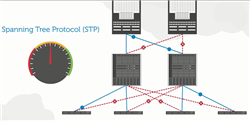Imagine if you could increase the capacity of your customers’ networks by up to 50%, increase the flexibility of their networks and extend the life of their core architectures. Think your customers would be interested? Well, now you can offer your customers these benefits with Dell Force10 data center switches equipped with Virtual Link Trunking or VLT.
 Traditional data centers are burdened with complex multi-tiered network architectures governed by inefficient and high-overhead protocols such as the Spanning Tree Protocol (STP). Originally, STP was designed to prevent network loops but the massive growth of virtualization and the increased demands of cloud computing have rendered STP impractical. The rapid adoption of virtualization, cloud computing services, and distributed computing platforms such as Hadoop have contributed to thinking about alternative network architectures without the inherent limitations present with STP. While a good solution at the time, that technology is over 25 years old and there are now better ways to increase network capacity.
Traditional data centers are burdened with complex multi-tiered network architectures governed by inefficient and high-overhead protocols such as the Spanning Tree Protocol (STP). Originally, STP was designed to prevent network loops but the massive growth of virtualization and the increased demands of cloud computing have rendered STP impractical. The rapid adoption of virtualization, cloud computing services, and distributed computing platforms such as Hadoop have contributed to thinking about alternative network architectures without the inherent limitations present with STP. While a good solution at the time, that technology is over 25 years old and there are now better ways to increase network capacity.
VLT eliminates the need for STP by increasing the intelligence of network forwarding devices, providing a non-blocking high performance network. View this video for an overview of how the VLT system works to create spine leaf architectures. For a detailed technical discussion of how Dell Force10 switches with VLT can eliminate blocked ports and enhance system capacity, check out this blog by Humair Ahmed.
 In addition to increasing capacity, the Dell Force 10 S4810 switch, one of the Dell Networking switches, enables the creation of multiple VLT domains – essentially allowing your customer to line them up one after another creating a flat network of switches that enables a “pay as you grow” architectural model. The switches act as modular building blocks and can be added to customers’ existing architectures, extending the life of their current equipment. VLT enhances Dell’s Distributed Core Architecture by extending scale and modularity helping to empower your customers to buy only as much as they need at any given time – unlike traditional architectures which can force customers to buy more than what they need. And you get to be the one that helps them decide how much they need, enhancing your relationship and acting as a trusted advisor to their IT department.
In addition to increasing capacity, the Dell Force 10 S4810 switch, one of the Dell Networking switches, enables the creation of multiple VLT domains – essentially allowing your customer to line them up one after another creating a flat network of switches that enables a “pay as you grow” architectural model. The switches act as modular building blocks and can be added to customers’ existing architectures, extending the life of their current equipment. VLT enhances Dell’s Distributed Core Architecture by extending scale and modularity helping to empower your customers to buy only as much as they need at any given time – unlike traditional architectures which can force customers to buy more than what they need. And you get to be the one that helps them decide how much they need, enhancing your relationship and acting as a trusted advisor to their IT department.
Finally, VLT is massively scalable. With the right switches, the number of devices that your customer can connect and still maintain maximum capacity is extremely large because of the lack of port blocking. Creating a massive flat high performance fabric network has never been easier. For more information on VLT, please contact Art Fewell or Humair Ahmed or continue the conversation on Twitter by following @DellNetworking and our experts, @AFewell and @Humair_Ahmed.